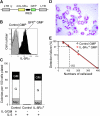Identification of eosinophil lineage-committed progenitors in the murine bone marrow
- PMID: 15955840
- PMCID: PMC2212039
- DOI: 10.1084/jem.20050548
Identification of eosinophil lineage-committed progenitors in the murine bone marrow
Abstract
Eosinophil lineage-committed progenitors (EoPs) are phenotypically isolatable in the steady-state murine bone marrow. Purified granulocyte/monocyte progenitors (GMPs) gave rise to eosinophils as well as neutrophils and monocytes at the single cell level. Within the short-term culture of GMPs, the eosinophil potential was found exclusively in cells activating the transgenic reporter for GATA-1, a transcription factor capable of instructing eosinophil lineage commitment. These GATA-1-activating cells possessed an IL-5Ralpha(+)CD34(+)c-Kit(lo) phenotype. Normal bone marrow cells also contained IL-5Ralpha(+)CD34(+)c-Kit(lo) EoPs that gave rise exclusively to eosinophils. EoPs significantly increased in number in response to helminth infection, suggesting that the EoP stage is physiologically involved in eosinophil production in vivo. EoPs expressed eosinophil-related genes, such as the eosinophil peroxidase and the major basic protein, but did not express basophil/mast cell-related mast cell proteases. The enforced retroviral expression of IL-5Ralpha in GMPs did not enhance the frequency of eosinophil lineage read-outs, whereas IL-5Ralpha(+) GMPs displayed normal neutrophil/monocyte differentiation in the presence of IL-5 alone. Thus, IL-5Ralpha might be expressed specifically at the EoP stage as a result of commitment into the eosinophil lineage. The newly identified EoPs could be the cellular target in the treatment of a variety of disorders mediated by eosinophils.
Figures




References
-
- Rothenberg, M.E., A. Mishra, E.B. Brandt, and S.P. Hogan. 2001. Gastrointestinal eosinophils. Immunol. Rev. 179:139–155. - PubMed
-
- Rothenberg, M.E. 1998. Eosinophilia. N. Engl. J. Med. 338:1592–1600. - PubMed
-
- Denburg, J.A., S. Telizyn, H. Messner, B. Lim, N. Jamal, S.J. Ackerman, G.J. Gleich, and J. Bienenstock. 1985. Heterogeneity of human peripheral blood eosinophil-type colonies: evidence for a common basophil-eosinophil progenitor. Blood. 66:312–318. - PubMed
-
- Nakahata, T., S.S. Spicer, and M. Ogawa. 1982. Clonal origin of human erythro-eosinophilic colonies in culture. Blood. 59:857–864. - PubMed
-
- Clutterbuck, E.J., E.M. Hirst, C.J. Sanderson, J.M. Wang, A. Rambaldi, A. Biondi, Z.G. Chen, and A. Mantovani. 1989. Human interleukin-5 (IL-5) regulates the production of eosinophils in human bone marrow cultures: comparison and interaction with IL-1, IL-3, IL-6, and GMCSF. Blood. 73:1504–1512. - PubMed
Publication types
MeSH terms
Substances
Grants and funding
LinkOut - more resources
Full Text Sources
Other Literature Sources

